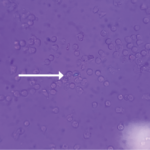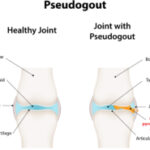Luckily, doctors have some therapeutic options for alleviating the symptoms. “We take the disease that’s most similar, and we borrow all the drugs,” Dr. Rosenthal says. “So pseudogout is treated almost exactly like gout.”
If only one or two joints are affected, Dr. Bettendorf says a localized treatment of injected corticosteroids can calm down the inflammation. “We can give somebody pretty quick relief with that and it’s pretty low risk to the patient,” she says. Non-steroidal anti-inflammatory drugs (NSAIDs) are another option, although a high-dose course may be less ideal for older patients with decreased kidney function. If the disease is caught early enough, the experts agree that colchicine can be particularly helpful.
Despite differences between the calcium pyrophosphate crystals and the uric acid crystals involved in gout, research suggests they use the same main pathways to induce inflammation. Those pathways involve the production of pro-inflammatory interleukin 1 (IL-1) and IL-6 cytokines, which help regulate the immune response. For that reason, some doctors have treated pseudogout that doesn’t respond to other medications with IL-1 beta antagonists, such as anakinra.
Other doctors, such as Nilanjana Bose, MD, MBA, a rheumatologist at Lonestar Rheumatology, Houston, emphasize that clinical data still haven’t provided clear direction on what to do when conventional treatments fail. “There are some recommended options, but I think these are all conjectural,” she says. “So I think there’s definitely a scope for how we can better treat these patients, especially those who are resistant to initial treatment and who continue to flare.”
Although some gout treatments can reduce the levels of circulating uric acid and thus eliminate existing monosodium urate crystals, the same intervention isn’t possible for CPPD—at least not yet.4 “I think that we’re getting closer to being able to reduce pyrophosphate and halt crystal formation, which I think will be much better than just treating the inflammation as the crystals accumulate with age,” Dr. Rosenthal says.
Even if untreated, pseudogout generally goes away in seven to 10 days. “If my medication is posing undue risk to the patient, it may make sense to treat them with a pain medication and let them ride it out,” Dr. Bettendorf says.
She cautions that low-grade fevers and systemic malaise, potential symptoms of acute CPPD, could also warn of a septic joint, which is a medical emergency. “If we’re seeing those systemic symptoms, in most situations, especially if they don’t have a prior known diagnosis of CPPD arthritis, we really do need the joint tap or arthrocentesis because we need that fluid from the joint to rule out infection and other things,” Dr. Bettendorf says.



